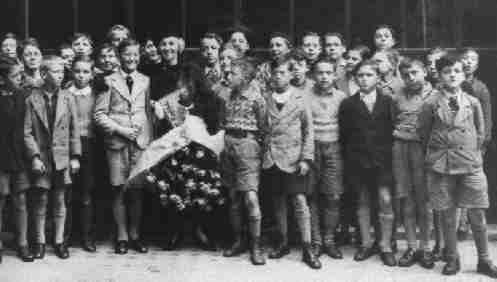
Figure 1.--This German class shows that boys age about 9-11 wore mostly suits and sailor suits to class, but some boys wore just sweaters and some wear French-looking smocks.


Figure 1.--This German class shows that boys age about 9-11 wore mostly suits and sailor suits to class, but some boys wore just sweaters and some wear French-looking smocks. |
German schools after the First World War continued the policy of allowing boys to wear the clothes parents selected for them. Given the horrors of the First World War it is understandable that German parents would have little reason to develop an interest in uniforms for school children, although the War did not affect British opinions on uniforms. Interestingly, sailor suits continued to be a popular style for boys, including older boys than wore sailor suits--both with short and long pants. This varied from Britain and America where it became increasingly rare in the 1920s for older boys to wear them. A few boys also wore smocks, at least in the early 1920s. Most boys that didn't wear sailor suits, however, wore short pants suits of various designs.
I do not have details on this class. I do not know what type of school it is or where it is located. I would guess the photograph was
taken about 1930. The boys appear to be about 11 to 13.
They have a lady teacher or are presenting an award to some celeberty.
These boys are wearing similar clothes, either suits or sweaters:
Smocks: Unlike younger boys during this period, none of these
boys wear smocks. Some younger boys wore smocks.
Sailor suits: None of the boys wear sailor suits.
Sweaters: Quite a few boys are dressed in sweaters without jackets. None of these boys wear ties. The sweaters are in a wide
variety of styles. Most are solid colors. One has a pattern. There
are many different color styles. One buttions all the way. Most only
button some of the way. Some are crew neck without any buttons.
Regular suits: The boys wearing suits are mostly wearing shirts without ties. Only two boys wear ties. Some boys have collared shirts
without ties or collarless shirts and sweaters. Both single and double
breasted suits in about equal proportions.
Short pants: All of the boys wear short pants. Some are still quite long at knee length. The material appears to be mostly flannel. Note that there are no notable creases.
Kneesocks: Most boys are wearing light colored kneesocks. There is only one boy wearing dark socks and none wearing ankle socks. Some of the kneesocks have patterened tops. All but one boy wears turn-over-top
socks as were commonly worn by British boys at the time. They are all solid colors.
Shoes: The boys mostly wear low-cut oxfords. Only a few boys wear the higher cut shoes.
Hair cut: The boys in the photograph mostly wear medium hair cuts. One boy at the back has rather wild hair.
Related Chronolgy Pages in the Boys' Historical Web Site
[Main Chronology Page]
[The 1900s]
[The 1910s]
[The 1920s]
[The 1930s]
Navigate the German school pages
[Main school uniform page]
[Main school uniform national page]
[Main German school uniform page]
[Imperial Germany]
[Weimar Republic]
[NAZI era]
[Post-war Years]
[Unified Germany]
Navigate the Relate Boys Historical Clothing Style Pages
[Main country page]
[Long pants suits]
[Short pants suits]
[Lederhosen]
[Kneesocks]
[Eton suits]
[Jacket and trousers]
[Blazer
[School sandals]
